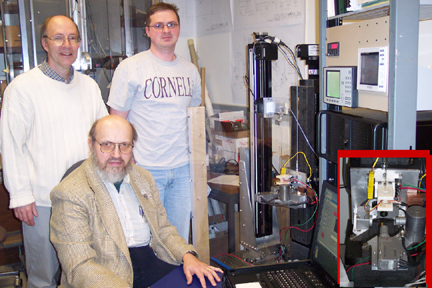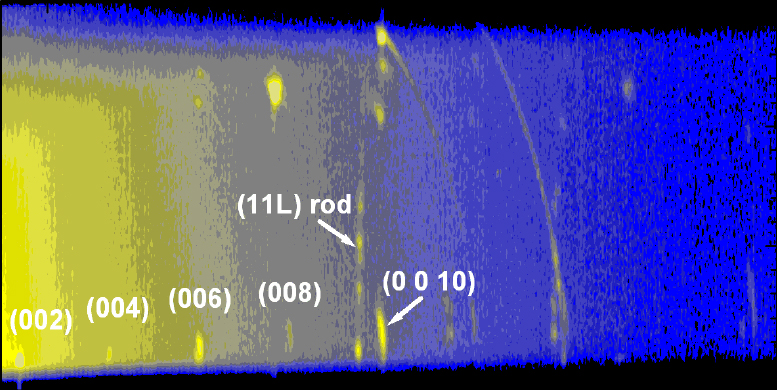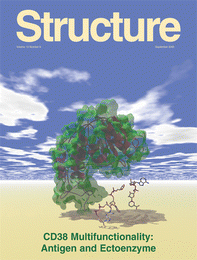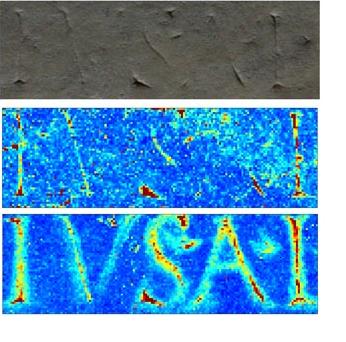X-RAY RUNS: Apply for Beamtime
2017 Nov 1 - Dec 21
2018 Feb 7 - Apr 3
2018 Proposal/BTR deadline: 12/1/17
2018 Apr 11 - Jun 4
2018 Proposal/BTR deadline: 2/1/18
Exciting Questions about Future X-ray Science at CHESS ERL Workshops
Adding a Second
Dimension to Surface Diffraction: Reciprocal
Space Mapping of Single-Crystal Scattering Rods
Detlef
Smilgies, Daniel Blasini, Shu Hotta, and Hisao
Yanagi
Results Published in the Journal of
Synchrotron Radiation
Complete article here (pdf)
online: 10/24/2005
_______________________________________________
Researchers Reveal Key Human Protein's Structure, Promising New AIDS and Cellular Calcium Release
Ithaca, NY. -- Cornell University researchers have discovered the 3-D crystal structure of a protein, human CD38, which may lead to important discoveries about how cells release calcium -- a mineral used in almost every cellular process. The findings also may offer insights into mechanisms involved in certain diseases, ranging from leukemia to diabetes and HIV-AIDS.
Published
by
the Cornell University News Service, September 19, 2005.
Complete article here (pdf)
online: 9/20/2005
_______________________________________________
G-line Student Received W.N. Findley Prize
Dr. Aaron Fleet, a 2005 graduate of the Applied & Engineering Physics Department, Cornell University, received the department's W.N. Findley Prize for the best paper by a graduate student, for his article, "Observed Effects of a Changing Step-Edge Density on Thin Film Growth Dynamics". The article is based on in situ X-ray scattering measurements of SrTiO3 growth using pulsed laser deposition. Measurements of the surface roughness immediately following an incident pulse of atoms suggest the presence of a smoothing mechanism caused by heightened kinetic energy of the incident atoms. The measurements were performed at the Cornell High Energy Synchrotron Source (CHESS) at station G3.
Phys. Rev. Lett, 94, 036102, 2005
Complete article here (pdf)
online: 8/17/2005
_______________________________________________
Scientists and Humanists Join Forces to use X-ray Technology to Shed new Light on Ancient Stone Inscriptions
Ithaca, NY. -- In an unusual collaboration among scientists and humanists, a Cornell University team has demonstrated a novel method for recovering faded text on ancient stone by zapping and mapping 2,000-year-old inscriptions using X-ray fluorescence (XRF) imaging.
Published by the Cornell University News Service, August 2, 2005.
Complete article here (pdf)
online: 8/02/2005
_______________________________________________
NIGMS Awards $16.9 Million to Center for
High-Throughput Structural Biology
The National Institute of General Medical Sciences (NIGMS) has announced that the Center for High-Throughput Structural Biology, led by George DeTitta, Hauptman-Woodward Medical Research Institute, Buffalo, NY, will receive a five-year, $16.9 million grant award. The Center is a collaborative effort of seven institutions including the Hauptman-Woodward Institution, Cornell High Energy Synchrotron Source, the University of Rochester, Stanford Synchrotron Radiation Laboratory, University of Washington, University of Pittsburgh and the Ontario Cancer Institute.
This award is part of the Protein Structure Initiative, begun in 2000 by the NIGMS, and now entering its second phase, is a national effort to rapidly determine larger numbers of protein structures and begin to address more challenging classes of proteins. During this second phase, the Center, named as one of six Specialized Technology Development Centers, will focus particularly on extending the structure determination pipeline to include optimization and growth of frozen, mounted, diffraction-quality crystals ready for structural analysis. This will offer the rapid benefits of this technology to a larger biological community.
Complete article here (pdf)
also see:
http://www.nih.gov/news/pr/jul2005/nigms-01.htm
online: 8/02/2005
_______________________________________________
Towards New Strategies for HIV Vaccine Development: Structure Solution of the Unliganded SIV gp120 Glycoprotein
Acquired
immunodeficiency syndrome (AIDS) in humans and
monkeys is caused by the human immunodeficiency
virus (HIV) and simian immunodeficiency virus (SIV),
respectively. Both viruses express a protein called
gp120, which binds to immune cells expressing another
protein, called CD4, on their surface. Binding of gp120
to CD4 causes the virus to infect cells. The structure
of gp120 bound to CD4 has been known since 1998;
however, the unbound form has eluded researchers for
decades. Stephen Harrison of
Crystal screening and data collection were performed at
Cornell High Energy Synchrotron Source (CHESS) beamline
F1 and Advanced Photon Source (APS) beamline 19ID. Parts
of the protein have a markedly different organization
than they do in the CD4-bound state. The new details
revealed by
Published by Nature, Vol. 433, No. 7028, pp. 834-841, (2005)
Complete article here (pdf)
online: 7/28/2005
_______________________________________________
NSF Awards Cornell $18 Million to Develop a New Source of X-rays
ITHACA, N.Y. -- The National Science Foundation (NSF) has awarded Cornell University $18 million to begin development of a new, advanced synchrotron radiation x-ray source, called an Energy Recovery Linac (ERL). The ERL, based on accelerator physics and superconducting microwave technology in which Cornell's Laboratory of Elementary Particle Physics (LEPP) is a world leader, will enable investigations of matter that are impossible to perform with existing X-ray sources.

Graphic by: "Review of Third and Next
Generation Synchrotron Light Sources" by Donald H. Bilderback,
Pascal Elleaume and Edgar Weckert, J. Phys. B, submitted 2004.
Schematic diagram of an Energy Recovery Linac source of synchrotron radiation. A bright electron source injects electrons at up to a 1.3 GHz rate into a superconducting radio frequency (RF) cavity that accelerates lectrons to full energy of 5 GeV (the green balls "surfing" on the crest of the RF traveling wave). They circulate around a return arc producing brilliant x-ray beams in undulators (shown in red rectangles). The circumference of the arc is adjusted so that the path length of the electrons returning to the linac is 180 degrees out of accelerating phase. Thus these (red ball) electrons ride in the trough of the RF wave and now give up their energy to the cavity. After being decelerated to low energy they are directed to a beam dump. Each electron makes one trip around the arc and its energy is recycled in the main linac, hence the name, Energy Recovery Linac.
We plan to adapt this schematic concept to the real physical layout of the current CESR storage ring by the addition of further underground tunnel to be connected to the present storage ring complex. The details are being worked out now and an upgrade plan will be presented to the NSF a few years from now.
More technical information on the ERL can be found
at the ERL website.
Complete article here (pdf)
Published in the Cornell Chronicle Volume 36 Number 23, February 24, 2005.
also see:
Cornell News February 21, 2005 Press Release (pdf)
Cornell Daily Sun, March 2, 2005 (pdf)
online: 2/25/2005
_______________________________________________
NSF Approves New C.U. X-Ray System
The National Science Foundation has given Cornell the green light to begin development of an Energy Recovery Linac (ERL), a new advanced synchrotron radiation X-ray source that has far-reaching implications for biology, chemistry and a host of other disciplines. The proposed ERL will feed into the Cornell Electron Storage Ring (CESR) underneath Alumni Field but will produce X-rays with greater capabilities than the University's current synchrotron radiations source can provide.
Complete article here (pdf)
Published in the Cornell Daily Sun Volume 121 Number
100, March 2, 2005
_______________________________________________

The Next Generation; a Capillary is Pulled
Don Bilderback, Tom Szebenyi and Sterling Cornaby are seen standing beside CHESS' next generation capillary glass puller. The first capillary was pulled on Friday, February 18, 2005 under LabView program control. This is a very great achievement as we have set up lots of new equipment over the course of the last year around an ABTech air bearing slide with on-board metrology through a dual Keyence High Speed LED/CCD Optical Micrometer. With this equipment, we hope to make better capillaries and to make them more quickly.
The hope in the long run is to make higher quality capillaries with slope errors below 60 mr (the best result from the prior puller). The puller mechanics are undergoing some performance testing at present. The good news is that we pulled our first fully drawn capillary with a profile similar to that of the old one, so control of figure has been demonstrated. We do have some "teething" problems, however. Periodic vibrations of the tiny stepping motors that rotate the glass in the middle of the furnace during drawing are rather strong and produce a 10 gram oscillation (peak to peak) in the nominal 100 gram tensioner system, keeping us from having a better result at the moment (170 microradian slope errors). When this problem is resolved, we hope to resume further pulling tests again.
Rong Huang (not shown), who has moved to the Advanced Photon Source is still helping us draw capillaries on the earlier puller (on occasions when he is back periodically in Ithaca), is teaching our new staff how to best draw quality capillaries and also helping to further develop the Matlab design tools for capillary optics development.
_______________________________________________
G-line Semi-Annual Symposium
G-line's Arthur Woll, Sr. Research Associate, hosted the second semi-annual G-Line Symposium on Wednesday, February 2, 2005 at Wilson Lab. Since it's (G-line's) commissioning in 2002 it's mission has been two-fold; to serve both as a lightning rod for new research directions and a training ground for future leaders in synchrotron-based research. This February's symposium showcased both the excellence and diversity of student-led research conducted at G-line. Sol Gruner, Director of CHESS, was very pleased with the research presented at the symposium and commented that "as an educator, it was gratifying to see how appreciative the students were of CHESS, not only of their advisors and the facility, but of the staff here at CHESS who they work with on a daily basis." Click here for more details about the Symposium, papers, presentations and images.
online: 02/02/2005
_______________________________________________
G-line's New Kappa Diffractometer
The newly received kappa
diffractometer, January 12, 2005, designed by Dave Nowak. Dave, a
Graduate student of Professor Shefford Baker's in the
Department of Materials Science and Engineering here at Cornell
University will be working diligently to commission the device and
use it during the Spring running period.
online: 01/12/2005
_______________________________________________
New High Pressure Gas Loading System
Filling DACs with gas pressure media is challenging. Dr. Zha has worked with technical designer Dana Richter, Safety Committee Chair Jeff White and an undergraduate mechanical engineer Eric Angle to build a new system that can load inert gasses at pressures up to 30,000 atmosphere.
Complete article here (pdf)
online: 1/12/2005
_______________________________________________



